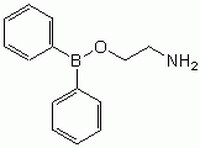100065 Sigma-Aldrich2-APB - CAS 524-95-8 - Calbiochem
A cell-permeable modulator of Ins(1,4,5)P3-induced Ca2+ release.
More>> A cell-permeable modulator of Ins(1,4,5)P3-induced Ca2+ release. Less<<Synonymes: 2-Aminoethoxydiphenylborate, (2-Aminoethoxy)diphenylborane
Produits recommandés
Aperçu
| Replacement Information |
|---|
Tableau de caractéristiques principal
| CAS # | Empirical Formula |
|---|---|
| 524-95-8 | C₁₄H₁₆BNO |
Prix & Disponibilité
| Référence | Disponibilité | Conditionnement | Qté | Prix | Quantité | |
|---|---|---|---|---|---|---|
| 100065-100MG |
|
Flacon en verre | 100 mg |
|
— |
| Product Information | |
|---|---|
| CAS number | 524-95-8 |
| ATP Competitive | N |
| Form | White crystalline solid |
| Hill Formula | C₁₄H₁₆BNO |
| Chemical formula | C₁₄H₁₆BNO |
| Hygroscopic | Hygroscopic |
| Reversible | N |
| Structure formula Image | |
| Quality Level | MQ100 |
| Applications |
|---|
| Physicochemical Information | |
|---|---|
| Cell permeable | Y |
| Dimensions |
|---|
| Materials Information |
|---|
| Toxicological Information |
|---|
| Safety Information according to GHS | |
|---|---|
| RTECS | ED6150000 |
| Safety Information |
|---|
| Product Usage Statements |
|---|
| Packaging Information | |
|---|---|
| Packaged under inert gas | Packaged under inert gas |
| Transport Information |
|---|
| Supplemental Information |
|---|
| Specifications |
|---|
| Global Trade Item Number | |
|---|---|
| Référence | GTIN |
| 100065-100MG | 07790788056766 |
Documentation
2-APB - CAS 524-95-8 - Calbiochem FDS
| Titre |
|---|
2-APB - CAS 524-95-8 - Calbiochem Certificats d'analyse
| Titre | Numéro de lot |
|---|---|
| 100065 |
Références bibliographiques
| Aperçu de la référence bibliographique |
|---|
| Brooke, R. T., et al. 2004. Lab. Invest. 84, 29. Gregory, R.B., et al. 2001. Biochem. J. 354, 285. Ma, H.T., et al. 2001. J. Biol. Chem. 276, 18888. Ascher-Landsberg, S., et al. 1999. Biochem. Biophys. Res. Commun. 264, 979. Maruyama, T., et al. 1997. J. Biochem. 122, 498. |
Citations
| Titre | |
|---|---|
|
|







